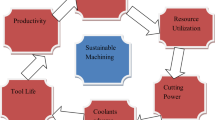Abstract
In pursuit of developing environmentally friendly techniques for machining, a lot of hard work has been done by researchers all over the world, and many fruitful results have been obtained. When focussing on cooling techniques, minimum quantity lubrication (MQL) is one such development that has proven to be highly useful in leading to a greener manufacturing process. The need of the hour is not just to compare its (MQL) benefits to dry and flood cooling. Rather, certain improvements need to be introduced in the MQL process to make it more effective and improve its performance. In this study, a similar effort has been made by introducing a Ranque-Hilsch vortex tube into the MQL process. Turning of commercially pure titanium (Grade 2) was commenced using uncoated tungsten carbide inserts. Variations in speed, feed and depth of cut were made. The experiments were designed using response surface methodology, and analysis of variance (ANOVA) was performed to identify the effect of the input parameters on the responses, i.e., surface roughness, cutting force, power and flank wear. Optimizations of the results proved that the Ranque-Hilsch vortex tube made significant improvements in the results and was suggested as a better method. These predictions were experimentally validated, thus making the MQL process more effective with a negligible cost addition and heading to a greener future in manufacturing industry.
Similar content being viewed by others
References
Gordana, Globočki. Lakić. Branislav S, Davorin K, Bogdan N, Janez K (2013) Effects of using MQL technique in metal. 13th Int. Conf. Tribol. pp 292–301
Kardekar AD (2005) Modeling and optimization of machining performance measures in face milling of automotive aluminium alloy A380 under different lubrication conditions for sustainable manufacturing. Uni. of Kentucky master’s thesis. 1-45
Astakhov VP (2010) Machining and machinability of materials. Int J Mach Mach Mater 7:1–16
Goldberg M (2012) Improving productivity by using innovative metal cutting solutions with an emphasize on green machining. Int J Mach Mach Mater 12:117–125
Itoigawa F, Childs THC, Nakamura T, Belluco W (2006) Effects and mechanisms in minimal quantity lubrication machining of an aluminum alloy. Wear 260:339–344
Kalita P, Malshe AP, Arun Kumar S, Yoganath VG, Gurumurthy T (2012) Study of specific energy and friction coefficient in minimum quantity lubrication grinding using oil-based nanolubricants. J Manuf Process 14:160–166
Ji X, Li B, Zhang X, Liang SY (2014) The effects of minimum quantity lubrication (MQL) on machining force, temperature, and residual stress. Int J Precis Eng Manuf 15:2443–2451
Pinar AM, Uluer O, Kirmaci V (2009) Optimization of counter flow Ranque-Hilsch vortex tube performance using Taguchi method. Int J Refrig 32:1487–1494
Selek M, Tasdemir S, Dincer K, Baskaya S (2011) Experimental examination of the cooling performance of Ranque-Hilsch vortex tube on the cutting tool nose point of the turret lathe through infrared thermography method. Int J Refrig 34:807–815
Liu J, Kevin Chou Y (2007) On temperatures and tool wear in machining hypereutectic Al-Si alloys with vortex-tube cooling. Int J Mach Tools Manuf 47:635–645
Nandy AK, Gowrishankar MC, Paul S (2009) Some studies on high-pressure cooling in turning of Ti-6Al-4V. Int J Mach Tools Manuf 49:182–198
Priarone PC, Rizzuti S, Rotella G, Settineri L (2012) Tool wear and surface quality in milling of a gamma-TiAl intermetallic. Int J Adv Manuf Technol 61:25–33
Islam MN, Anggono JM, Pramanik A, Boswell B (2013) Effect of cooling methods on dimensional accuracy and surface finish of a turned titanium part. Int J Adv Manuf Technol 69:2711–2722
Liu NM, Chiang KT, Hung CM (2013) Modeling and analyzing the effects of air-cooled turning on the machinability of Ti-6Al-4V titanium alloy using the cold air gun coolant system. Int J Adv Manuf Technol 67:1053–1066
Sharma VS, Singh G, Sørby K(2015) A review on minimum quantity lubrication for machining processes. Materials and manufacturing processes 30:935–953
Ginting YR, Boswell B, Biswas WK, Islam MN (2016) Environmental generation of cold air for machining. Procedia CIRP 40:649–653
Ezugwu EO, Wang ZM (1997) Materials titanium alloys and their machinability. J Mater processing Technol 68:262–274
An QL, Fu YC, Xu JH (2011) Experimental study on turning of TC9 titanium alloy with cold water mist jet cooling. Int J Mach Tools Manuf 51:549–555
Author information
Authors and Affiliations
Corresponding author
Rights and permissions
About this article
Cite this article
Singh, G., Sharma, V.S. Analyzing machining parameters for commercially puretitanium (Grade 2), cooled using minimum quantity lubrication assisted by a Ranque-Hilsch vortex tube. Int J Adv Manuf Technol 88, 2921–2928 (2017). https://doi.org/10.1007/s00170-016-8982-9
Received:
Accepted:
Published:
Issue Date:
DOI: https://doi.org/10.1007/s00170-016-8982-9



